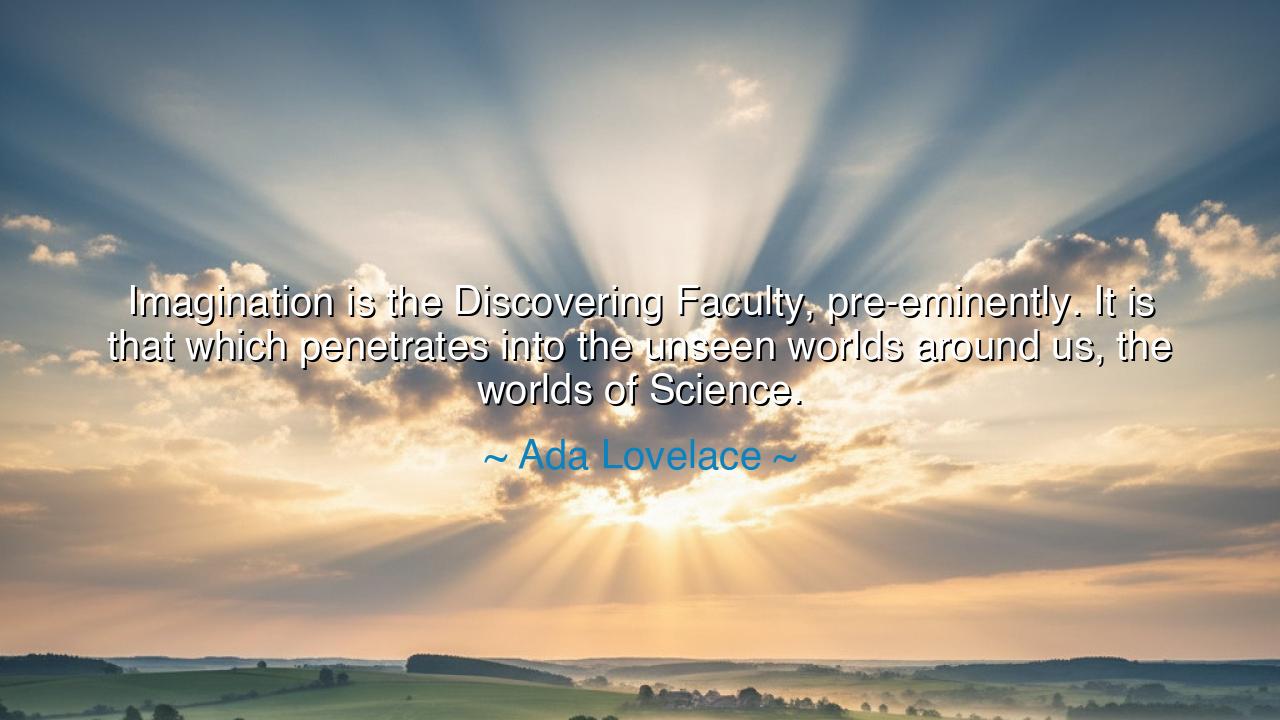
Imagination is the Discovering Faculty, pre-eminently. It is that
Imagination is the Discovering Faculty, pre-eminently. It is that which penetrates into the unseen worlds around us, the worlds of Science.






“Imagination is the Discovering Faculty, pre-eminently. It is that which penetrates into the unseen worlds around us, the worlds of Science.” — so declared Ada Lovelace, the enchantress of numbers, the first prophetess of the digital age. In this profound reflection, she wove together two forces often thought opposed — imagination and science — and revealed their sacred union. Her words stand as a torch passed down from the dawn of computation, lighting the path for all seekers of truth. She reminds us that imagination is not mere fantasy, but the Discovering Faculty itself — the divine eye that perceives what is hidden, the soul’s power to glimpse realities not yet born.
To understand her meaning, one must first behold the woman herself — Augusta Ada Byron Lovelace, daughter of the poet Lord Byron and student of the mathematician Charles Babbage. From her father she inherited the fire of poetry; from her mother, the precision of logic. In her, these forces did not war — they intertwined. When Babbage showed her his Analytical Engine, a great machine of gears and thought, she saw in it more than a calculating device. Where others saw brass and motion, she saw the unseen world of numbers, a realm where mind and mechanism might one day merge. She imagined a future where machines could not only compute but create — composing music, weaving art, even reflecting thought itself. Thus, in the mid-1800s, she dreamed the birth of the computer.
In calling imagination the Discovering Faculty, Ada Lovelace taught that discovery is not made by cold logic alone. Logic is the lamp that reveals the path, but imagination is the flame that kindles it. The scientist without imagination is a sailor without a compass, seeing only the waves before him and not the horizon beyond. It is imagination that pierces the veil of the known, that dares to ask, “What if?” before there is proof. For every truth that science reveals was once a dream, glimpsed only in the inner eye of one who believed that the unseen could become real.
Consider the example of Isaac Newton, who sat beneath the apple tree and wondered not merely why it fell, but what invisible hand pulled it downward. That wondering — that act of imagination — opened the unseen world of gravity and the laws of motion. Or think of Albert Einstein, whose mind soared beyond the constraints of his time. It was not experiment, but imagination, that led him to envision himself riding upon a beam of light — and from that vision came the revelation of relativity. The greatest scientists have always been dreamers first.
Lovelace’s wisdom lies also in her choice of words — she calls imagination the power that penetrates “the unseen worlds around us, the worlds of Science.” She did not speak of distant galaxies or spiritual heavens, but of science itself as a hidden world. For science is not only a collection of facts; it is a living mystery, an unfolding cosmos of understanding. The unseen worlds she names are the invisible forces — the atoms, energies, and patterns — that underlie all existence. Imagination is the key that unlocks them, the bridge between mind and matter. Without imagination, the doors of these worlds remain closed, and humanity remains blind to its own potential.
Her teaching also carries a moral truth. To imagine deeply is to believe that the unknown can be known, that darkness conceals discovery. It is an act of courage, for imagination dares to step into uncertainty and create meaning where none yet exists. Many feared Ada’s vision, dismissing her ideas as the delusions of a dreamer. Yet her imagination proved prophetic: the Analytical Engine she envisioned became the ancestor of every computer that followed. The unseen world she penetrated has since grown into the digital universe that now surrounds us — proof that imagination is not a luxury but the root of civilization’s advance.
So let her words be a beacon to all who seek truth. Imagination is not idle fancy — it is the mind’s highest power, the gateway to discovery. Cultivate it as a sacred discipline. When you study, do not only memorize; dream. When you invent, do not only solve; envision. When the world says “it cannot be done,” let your imagination whisper “perhaps it can.” Every breakthrough begins as a vision in the unseen. Every step forward begins with a gaze into the dark.
Thus, remember the lesson of Ada Lovelace, the woman who saw music in machines and truth in dreams: Imagination is the first science. It is the eye that looks beyond the veil, the flame that guides both poet and physicist alike. Use it not to escape the world, but to reveal it — for through imagination, humanity discovers not only new worlds, but itself.






AAdministratorAdministrator
Welcome, honored guests. Please leave a comment, we will respond soon